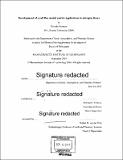Development of a cell flux model and its application to nitrogen fixers
Author(s)
Inomura, Keisuke
DownloadFull printable version (18.69Mb)
Other Contributors
Massachusetts Institute of Technology. Department of Earth, Atmospheric, and Planetary Sciences.
Advisor
Michael J. Follows.
Terms of use
Metadata
Show full item recordAbstract
.Quantifying and modeling the macroscopic ecological and biogeochemical effects of cellular physiology and metabolism is a challenge: most quantitative "systems biology" models are focused at the metabolic and individual scale. In this study, we develop and apply a simplified metabolic model at the individual scale, which we call "the cell flux model", in order to quantify costs and benefits of nitrogen fixers. In Chapter 2, we develop the cell flux model for heterotrophic nitrogen fixers in order to examine and quantify the direct and indirect energy costs of nitrogen fixation. We have tested the model using data from Azotobacter vinelandii grown in continuous culture. The model indicates that the direct energy cost of nitrogen fixation is relatively small, whereas oxygen management to protect nitrogenase becomes dominant as the oxygen concentration increases. In Chapter 3, we have adapted the cell flux model of Azotobacter vinelandii to consider the organisms' response to the presence of ammonium in the environment. The model shows that even under high oxygen concentrations and with high ambient concentrations of fixed nitrogen, nitrogen fixation occurs if there is sufficient carbohydrate resource available to fully consume intracellular oxygen. Most nitrogen fixers in the ocean are photoautotrophic. Thus, in Chapter 4, we extend the cell flux model to resolve phototrophy and use it simulate and study light and nutrient colimitation of Synechococcus spp. as observed in published continuous culture studies. In order to capture the observed variations in elemental composition with light and resource availability, we resolve the macromolecular composition of the cells. The highly simplified model is able to simulate key aspects of the laboratory cultures including explicit prediction of the average elemental composition and maximum growth rates under different environmental limitations. In Chapter 5, we have applied the cell flux model to simulate laboratory studies, and interpreted the ecological costs for the photoautotrophic nitrogen fixer Crocosphaera watsonii. Our model suggests that these organism also utilize multiple oxygen protection strategies, including scavenging oxygen with excess respiration, changing their size, and using extracellular polymeric substances as a barrier to the invasion of oxygen into the cell.
Description
Thesis: Ph. D., Massachusetts Institute of Technology, Department of Earth, Atmospheric, and Planetary Sciences, 2016. Cataloged from PDF version of thesis. Includes bibliographical references.
Date issued
2016Department
Massachusetts Institute of Technology. Department of Earth, Atmospheric, and Planetary SciencesPublisher
Massachusetts Institute of Technology
Keywords
Earth, Atmospheric, and Planetary Sciences.